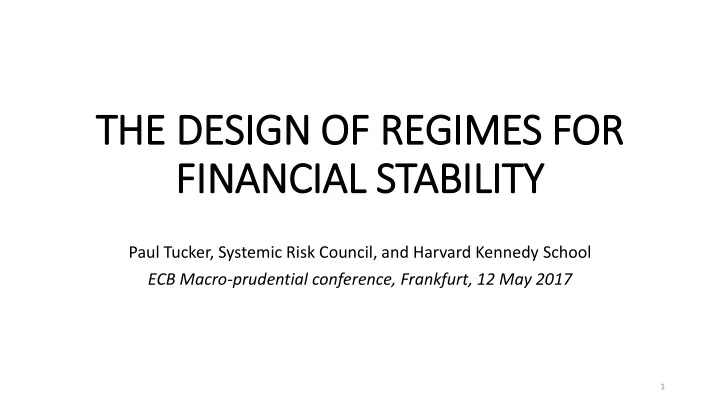

THE DESIGN OF REGIMES FOR FIN INANCIAL STABILITY Paul Tucker, Systemic Risk Council, and Harvard Kennedy School ECB Macro-prudential conference, Frankfurt, 12 May 2017 1
OUTLINE 1)Nature of stability problem 2)What can decently be delegated 3)Missing regimes persist 2
Social Costs 1) Booms : misallocated resources and over-indebtedness. Possibly impaired productivity 2) Busts : collapse of system, withdrawal of core financial services. Economic slump New policy regimes overwhelmingly focused on (2) 3
Frictions associated with Busts • Fire sales: collateral, wealth and cost of capital effects • Inter-linkages: cascade of defaults • Bankruptcy non-linearities: cessation of services, close out • Barriers to entry: fresh capacity does not substitute for failed firms New regimes overwhelmingly focused on avoiding bankruptcies and, a new emphasis, reducing social costs of bankruptcy (resolution policy) 4
A Standard for Resilience • Core of regime for resilience of financial system as a whole: a standard of resilience • Three inputs: 1) Societal tolerance for crises 2) Assumption re first-loss generating process 3) Propagation of shocks: structure/map of system 5
The Resilience Commons • Common to think of finstab as a public good • Resilience better thought of as a common good: non- excludable but rivalrous • Taking stability for granted, intermediaries have incentives to take more risk than the market grasps • This consumes the resilience grass 6
The problem of Hidden Actions • Common to frame public policy in terms of Pigouvian taxes • Very hard to make work in presence of hidden actions (general moral hazard) • Reg Arb endemic: finance is a shape shifter • So: a problem of the commons bedeviled by hidden actions 7
Components of a regime for system resilience • Application of Resilience Standard to different sectors and activities • Micro-supervision of individual intermediaries designed to detect and deter hidden actions • Macro-system surveillance to identify threats to system, and hidden actions beyond ‘regulatory perimeter’ • Macro-prudential policy , which dynamically adjusts core regulatory parameters to maintain desired degree of system resilience under changing conditions (ie shifts in stochastic loss-generation or propagation mechanism) 8
Applying the Resilience Standard • Pushes in the direction of functional regulation • Should take account of fault lines in infrastructure (neglected pre-crisis) • Institutional design : implies need for unitary authority that either sets or blesses/vetoes application by sector- specialist regulators 9
Micro-supervision • Much more important than generally recognized in macro- finance literature due to Hidden Actions problem • Rules-based system doomed to failure • Adjudicatory judgments • Institutional design : implies need for forensic skills and authority 10
Macro-system surveillance • Requires synthesis of information and analysis on intermediaries, markets, infrastructure, macro economy • Institutional design : either 1) Unitary authority for surveillance, or 2) Seamless information flows • Info flows: incentives problem; and hard to evidence obstructionism 11
Dynamic macro-pru policy • Problem of credible commitment • Institutional design : implies delegation to an independent agency, with full access to all information 12
High-level institutional structure 1) A high-level authority for stability policy: applying the RS 2) Micro-supervisors for all parts of system 3) An authority responsible for system surveillance 4) A macro-prudential policy authority • Natural to combine (1), (3) and (4) • US close to separating all four. UK close to combing all four under single roof, given FPC override power over FCA 13
Implications for central banks • Objective: monetary system stability • Don ’ t make big distributional choices : Better (for legitimacy) to set limits on % of intermediary portfolios accounted for by high LTV or LTI mortgages etc than to set rules binding on households • As multiple-mission agencies, must have strong incentives to pursue all responsibilities with equal seriousness: separate committees 14
The Gap • Ensuring system resilience not same as managing the credit cycle mitigating every resource misallocation caused by fin system pathologies leaning against real economy over-indebtedness that does not threaten system stability • Not same as addressing the first type of social cost • Missing regime for national balance-sheet management : akin to fiscal policy 15
Need for debate on the Gap • A lot of macro-finance literature on pecuniary externalities is about the social costs of booms • But not really what is happening in policy world • Priority on system resilience is right • But need to face up to the Gap 16
There is more than one Gap • A complete regime of regimes would cover: 1) Nominal stability and inter-temporal stabilization 2) Financial/Monetary system resilience 3) National balance-sheet management 4) Global macroeconomic imbalances • Central banks can lead on only (1) and (2). Could advise on (3) and (4) 17
Recommend
More recommend